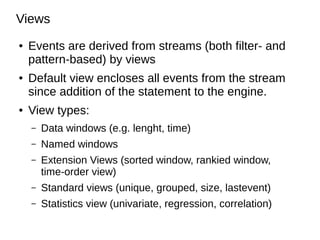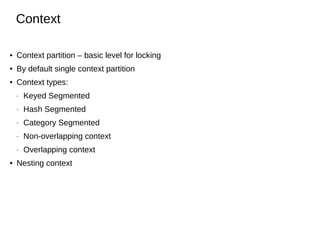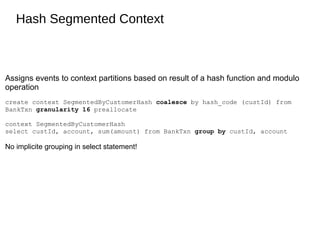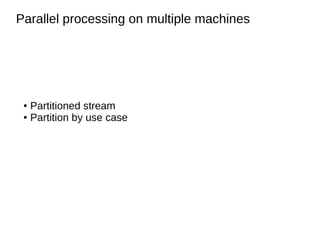Parallel Complex Event Processing
- 1. Parallel Complex Event Processing Karol Grzegorczyk 03-06-2013
- 4. Complex Event Processing solutions ● Open Source: – – Drools Fusion – Storm – ● Esper WSO2 Complex Event Processor Proprietary software – Oracle Complex Event Processing – StreamBase Complex Event Processing – Informatica RulePoint – TIBCO Complex Event Processing
- 5. Esper ● Two editions: ― Open source library ― Enterprise server based on Jetty ● Core component of Esper is a CEP engine. ● CEP engine is working like database turned upside-down ● Expressions are defined in Event Processing Language (EPL) ― Declarative domain specific language ― Similar with the SQL query language but differs from SQL in its use of views rather than tables and events instead of records (rows) ― Views are reused among EPL statements for efficiency! select * from OrderEvent.win:length(5)
- 6. Streams ● Complex event can be build based on several data streams. select * from AlertEvent as a, NewsEvent as n where a.symbol = n.symbol ● Esper defines two types of data streams: ― Filter-based event stream select * from OrderEvent(itemType='shirt') ― Pattern-based event stream select * from pattern [ OrderEvent(itemType='shirt') -> OrderEvent(itemType='trousers')] ● It is possible to join between filter-based and pattern-based streams! ● Events can be forwarded to others streams using INSERT INTO keywords. ● It is also possible to update event (using UPDATE keyword) before it applies to any selecting statements
- 7. Views ● ● ● Events are derived from streams (both filter- and pattern-based) by views Default view encloses all events from the stream since addition of the statement to the engine. View types: – Data windows (e.g. lenght, time) – Named windows – Extension Views (sorted window, rankied window, time-order view) – Standard views (unique, grouped, size, lastevent) – Statistics view (univariate, regression, correlation)
- 8. Esper processing ● ● ● Update listeners and subscriber objects are associated with EPL statements By defualt listeners and subscribers are notified when new event that match EPL query arrive (insert stream) In addition listeners and subscribers can be notified when some event that match EPL query is removed from the stream (due to the limit of particular window)
- 10. Filtering Esper provides two types of filtering: ● Stream-level filtering select * from OrderEvent(type= 'shirt') ● Post-data-window filtering select * from OrderEvent where type = 'shirt'
- 13. Stream-level filtering vs post-data-window filtering select * from OrderEvent(type= 'shirt') vs select * from OrderEvent where type = 'shirt' The first form is preferred, but still sometimes post-data-window filtering is desired: Select one hundred orders and calculate average price of trousers. select avg(price) from OrderEvent.win:length(100) where type = 'trousers'
- 14. Data Windows ● Basic windows: ― ― Length batch window (win:length_batch) ― Time window (win:time) ― ● Length window (win:length) Time batch window (win:time_batch) Advanced time windows ― Externally-timed window (win:ext_timed) ― Externally-timed batch window (win:ext_timed_batch) ― Time-Length combination batch window (win:time_length_batch) ― Time-Accumulating window (win:time_accum) ― Keep-All window (win:keepall) ― First Length (win:firstlength) ― First Time (win:firsttime)
- 17. Scaling Esper ● ● According to the documentation Esper exceeds over 500 000 event/s on a dual CPU 2GHz Intel based hardware, with engine latency below 3 microseconds average (below 10us with more than 99% predictability) on a VWAP benchmark with 1000 statements registered in the system - this tops at 70 Mbit/s at 85% CPU usage. Parallel processing – Within one machine - – Context partitions With multiple machines - Partitioned stream - Partition by use case
- 18. Context ● Context partition – basic level for locking ● By default single context partition ● Context types: ― ― Hash Segmented ― Category Segmented ― Non-overlapping context ― ● Keyed Segmented Overlapping context Nesting context
- 19. Keyed Segmented Context create context ByCustomerAndAccount partition by custId and account from BankTxn context ByCustomerAndAccount select custId, account, sum(amount) from BankTxn Implicite grouping in select statement.
- 20. Hash Segmented Context Assigns events to context partitions based on result of a hash function and modulo operation create context SegmentedByCustomerHash coalesce by hash_code (custId) from BankTxn granularity 16 preallocate context SegmentedByCustomerHash select custId, account, sum(amount) from BankTxn group by custId, account No implicite grouping in select statement!
- 21. Category Segmented Context Assigns events to context partitions based on the values of one or more event properties, using a predicate expression(s) to define context partition membership. create context CategoryByTemp group temp < 65 as cold, group temp between 65 and 85 as normal, group temp > 85 as large from SensorEvent context CategoryByTemp select context.label, count(*) from SensorEvent
- 22. Non-overlapping context Non-overlapping context is created when start condition is meet and ended when end condition is meet. There is always either one or zero context partions. create context NineToFive start (0, 9, *, *, *) end (0, 17, *, *, *) context NineToFive select * from TrafficEvent(speed >= 100)
- 23. Overlapping context This context initiates a new context partition when an initiating condition occurs, and terminates one or more context partitions when the terminating condition occurs. create context CtxTrainEnter initiated by TrainEnterEvent as te terminated after 5 minutes context CtxTrainEnter select t1 from pattern [t1=TrainEnterEvent -> timer:interval(5 min) and not TrainLeaveEvent(trainId = context.te.trainId)]
- 24. Context nesting In case of nested contextx the context declared first controls the lifecycle of the context(s) declared thereafter. create context NineToFiveSegmented context NineToFive start (0, 9, *, *, *) end (0, 17, *, *, *), context SegmentedByCustomer partition by custId from BankTxn context NineToFiveSegmented select custId, account, sum(amount) from BankTxn group by account
- 25. Partitioning without context declaration Grouped data window std:groupwin() What is the difference between: select avg(price) from OrderEvent.std:groupwin(itemType).win:length(10) And select avg(price) from OrderEvent.win:length(10) group by itemType ?
- 26. Parallel processing on multiple machines Partitioned stream ● Partition by use case ●
- 27. [Esper Enterprise Edition Reference]
- 28. Thank you
Editor's Notes
- #4: CEP assumes multiple sources Synonym of CEP is 'event correlation'.
- #6: Whereas a typical database stores data, and runs queries against the data, a CEP data stores queries, and runs data through the queries. Language to specify expression-based event pattern matching
- #8: Does the 'insert into' is used to insert into other streams of events or only into named windows?
- #9: Data windows will be discussed later
- #15: Stream-level-filtering allows only simple filters
- #16: In case of post-data-window filtering update listener is not notified, but window is used (filled) Post-data-window filtering allows more sophisticated filtering
- #17: Stream-level filetering has built in optimization. Sometimes post-data-window is neede
- #34: The granularity defines the maximum degree of parallelism

![Big Data classification
[http://en.wikipedia.org/wiki/File:3_states_of_data.jpg]](https://image.slidesharecdn.com/parallelcomplexeventprocessing-131227075100-phpapp02/85/Parallel-Complex-Event-Processing-2-320.jpg)



![Streams
●
Complex event can be build based on several data streams.
select * from AlertEvent as a, NewsEvent as n
where a.symbol = n.symbol
●
Esper defines two types of data streams:
―
Filter-based event stream
select * from OrderEvent(itemType='shirt')
―
Pattern-based event stream
select * from pattern [
OrderEvent(itemType='shirt') -> OrderEvent(itemType='trousers')]
●
It is possible to join between filter-based and pattern-based streams!
●
Events can be forwarded to others streams using INSERT INTO keywords.
●
It is also possible to update event (using UPDATE keyword) before it applies
to any selecting statements](https://image.slidesharecdn.com/parallelcomplexeventprocessing-131227075100-phpapp02/85/Parallel-Complex-Event-Processing-6-320.jpg)


![[Esper Reference]](https://image.slidesharecdn.com/parallelcomplexeventprocessing-131227075100-phpapp02/85/Parallel-Complex-Event-Processing-9-320.jpg)

![[Esper Reference]](https://image.slidesharecdn.com/parallelcomplexeventprocessing-131227075100-phpapp02/85/Parallel-Complex-Event-Processing-11-320.jpg)
![[Esper Reference]](https://image.slidesharecdn.com/parallelcomplexeventprocessing-131227075100-phpapp02/85/Parallel-Complex-Event-Processing-12-320.jpg)


![[Esper Reference]](https://image.slidesharecdn.com/parallelcomplexeventprocessing-131227075100-phpapp02/85/Parallel-Complex-Event-Processing-15-320.jpg)
![[Esper Reference]](https://image.slidesharecdn.com/parallelcomplexeventprocessing-131227075100-phpapp02/85/Parallel-Complex-Event-Processing-16-320.jpg)






![Overlapping context
This context initiates a new context partition when an initiating condition occurs, and
terminates one or more context partitions when the terminating condition occurs.
create context CtxTrainEnter initiated by TrainEnterEvent as te
terminated after 5 minutes
context CtxTrainEnter select t1 from pattern [t1=TrainEnterEvent ->
timer:interval(5 min) and not TrainLeaveEvent(trainId =
context.te.trainId)]](https://image.slidesharecdn.com/parallelcomplexeventprocessing-131227075100-phpapp02/85/Parallel-Complex-Event-Processing-23-320.jpg)



![[Esper Enterprise Edition Reference]](https://image.slidesharecdn.com/parallelcomplexeventprocessing-131227075100-phpapp02/85/Parallel-Complex-Event-Processing-27-320.jpg)
